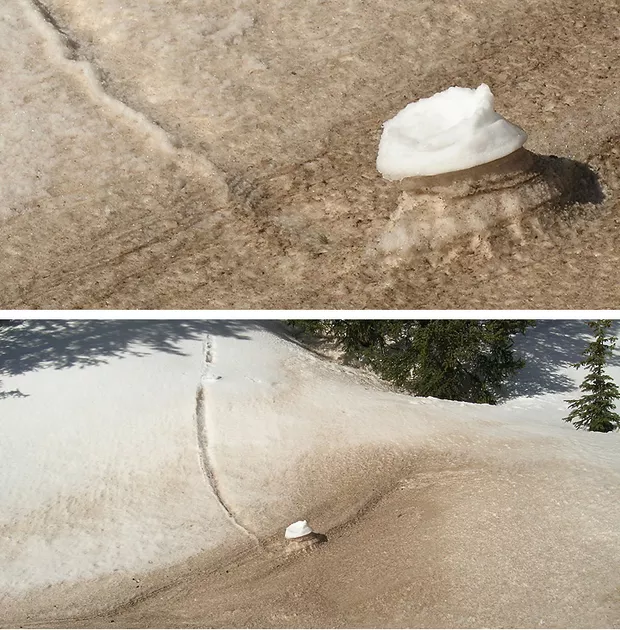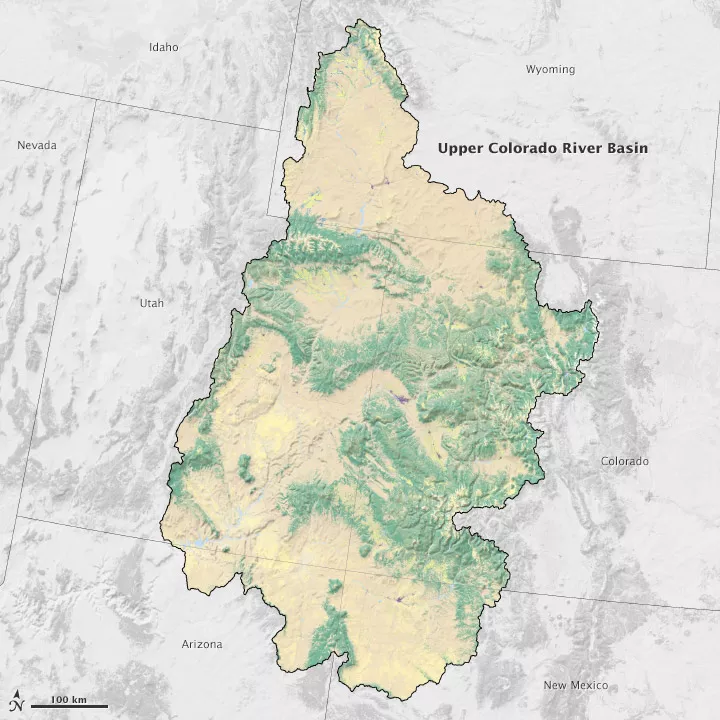In the Rocky Mountains, as in many mountain ranges worldwide, snowpack is getting dirtier. Winds carry fine sediment particles from arid regions, and dust lofted high enough into the atmosphere can travel hundreds or even thousands of miles. Contents can include eroded soil, ground disrupted by paving and construction, land disturbed by grazing and farming, and fine debris from wildfires. When these dust particles land on snow, they darken the snow surface. Because dark surfaces absorb more sunlight than light surfaces, the dust speeds snowmelt. The accelerated melt has multiple consequences:
- Faster snow -cover retreat means earlier soil exposure and more evaporation.
- Faster snowmelt bloats rivers sooner each year, overwhelming river systems in the spring and early summer.
- Earlier and faster runoff potentially leaves rivers drier in late summer.
In short, dusty snow can cause water shortages in Rocky Mountain communities that depend on snowpack.
The what and where of dust
The more dust, the darker the surface and the faster snow will melt. “Sunlight is the major snow melter,” said Jeff Deems, a research scientist as NSIDC. “It’s not air temperature.” Fresh snow reflects anywhere from 90 to 95 percent of solar energy. “Very dusty snow, on the other hand, may reflect as little as 30 percent, meaning 70 percent is absorbed,” Deems said. If you more than double absorbency, you’re dramatically increasing the rate at which snow melts.
Dust storms boil out of the arid regions of the West. Across Colorado, for instance, much of the snowpack dust comes from the Colorado Plateau—a dry region centered on the Four Corners of Utah, Colorado, New Mexico, and Arizona. But dust does not simply come from areas that are dry, it comes from areas where the soil surface has been disturbed. Jason Neff, a professor of Geology and Environmental Studies at the University of Colorado Boulder, said, “We know humans have increased dust by disturbing desert soils: grazing animals, driving vehicles, building roads and towns.” With the settlement of the West, post 1860s, dust has increased. Deems said, “It wasn’t completely dust free before, but by the mid to late 1800s the dust levels jumped up seven-fold.”
Is the extreme the new norm?
Since the year 2000, increased temperature and prolonged drought have been drying the West. “There is indication from our colleagues out in the desert that the extreme scenarios could be a more frequent occurrence,” Deems said. Timing is everything. Earlier soil exposure can decrease annual runoff. A 2020 study concluded that the Colorado River’s discharge has fallen by 9.3 percent for every degree Celsius (1.8 degrees Fahrenheit) of warming, thanks to snow loss.
Exposed land evaporates more water. Earlier snowmelt also triggers an earlier growing season, allowing for vegetation to take up and evaporate water. “Nothing can be done about the loss of water to evapotranspiration,” said Thomas Painter, a research scientist at the NASA Jet Propulsion Laboratory. “It’s permanent.”
The Colorado River brings water to more than 40 million people in cities like Denver, Las Vegas, Phoenix, and Los Angele. The river is punctuated by dams that store its water in reservoirs. Lakes Powell and Mead combined can store about four years’ worth of Colorado River flow, but for the Upper Colorado Basin, snowpack is the most important reservoir. “We can store way more water as snow in the mountains than we can in our reservoirs—vastly more,” Deems said. “So, the longer the snow sticks around, the longer we have water. If flow comes early, then we’re stuck in late summer with only what could be stored in surface water reservoirs.”
Faster snowmelt also suggests a surge in river flow, and when rivers come up faster, water management gets complicated. “It’s just like if you turn on your sink, and if you only have a 101 gallons of water potential and your faucet blasts a hundred gallons out before you even get a cup underneath, then the person behind you in line may only fill their cup half full,” Painter said.
By the year 2050, warming could drop the waterflow of the Colorado River by 14 to 31 percent. “It’s not good,” said Painter. “To put a dent in the flow like that—people are going to feel it.” As of 2020, the Colorado River supports a regional economy worth $1.4 trillion, including 16 million jobs. Something can still be done to preserve the water. If the amount of dust blown onto Colorado River snowpacks can be reduced, a more stable snow pack lingers, giving way to a trickling river system rather than a roaring, untamable beast. Painter added, “By reducing dust loading, we may stem some climate change tide in terms of water loss.”
References
Deems, J.S. et al. 2013. Combined impacts of current and future dust deposition and regional warming on Colorado River Basin snow dynamics and hydrology. Hydrology and Earth System Sciences 17: 4401-4413. doi:10.5194/hess-17-4401-2013.
Eilperin, J. 2020. Climate change has stolen more than a billion tons of water from the West’s most vital river. The Washington Post.
Hobbins, M., and J. Barsugli. 2020. Threatening the vigor of the Colorado River. Science 367(6483): 1192-1193, doi:10.1126/science.abb3624.
Lukas, J., and E. Payton, eds. 2020. Colorado River Basin Climate and Hydrology: State of the Science. Western Water Assessment, University of Colorado Boulder. doi:10.25810/3hcv-w477.
Milly, P.C.D., and K.A. Dunne. 2020. Colorado River flow dwindles as warming-driven loss of reflective snow energizes evaporation. Science 367(6483): 1252-1255, doi:10.1126/science.aay9187.
Painter, T.H. et al. 2010. Response of Colorado River runoff to dust radiative forcing in snow. Proceedings of the National Academy of Sciences doi:10.1073/pnas.0913139107.
Painter, T.H. et al. 2017. Variation in rising limb of Colorado River snowmelt runoff hydrograph controlled by dust radiative forcing in snow. Geophysical Research Letters 45(2): 797-808, doi:10.1002/2017GL075826.

